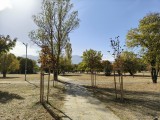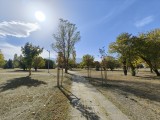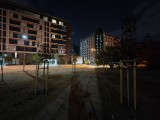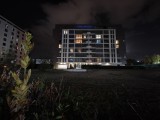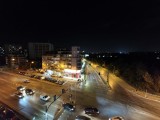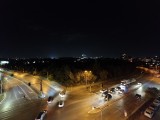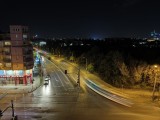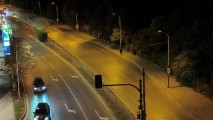Oppo Find N3 Flip review

Three high-end cameras
The camera setup on the back of the Oppo Find N3 Flip has seen the biggest upgrade since the Find N2 Flip. The most notable update is the first-ever telephoto on a Flip phone (32MP 2x), but the N3 Flip can also brag with a 50MP OIS primary and a 48MP AF ultrawide with macro capabilities.

The primary camera on the N3 Flip uses the same Sony IMX 890 sensor - it is a 1/1.56" imager with 1.0µm pixels and a 50MP nominal resolution (Quad Bayer, so 12.5MP resulting images). It is coupled with a 24mm-equivalent f/1.8 aperture lens, also identical to the N2 Flip's, but it is now optically stabilized (OIS).
The ultrawide camera relies on a 48MP Sony IMX581 1/2.0" sensor with 0.8µm pixels. It is coupled with a 14mm f/2.2 lens. Autofocus is available, and so is macro photography, starting from just 4cm away.
The telephoto camera is rather basic, but still interesting, and also a first on a modern Flip phone. It uses a 32MP Sony IMX709 RGBW 1/2.74" sensor with 0.7µm pixels, and it saves 8MP images. There is a 47mm f/2.0 lens here for 2x optical zoom. Furthermore, this camera supports up to 5x high-quality magnification via in-sensor zoom.
Finally, the N3 Flip has the same selfie camera as the N2 Flip, which uses the same sensor as the telephoto, but saves 32MP images instead of 8MP. So, the Sony IMX 709 sensor (32MP, 1/2.74") is paired with a 21mm equivalent lens with an f/2.4 aperture. The selfie cam focus is fixed.
All cameras support 4K30 video capturing and electronic stabilization.
Camera app
The Oppo/OnePlus-Hasselblad collaboration has made it to the Find N3 Flip, which means that the Swedish camera company has pitched in with some color science or similar.

The Hasselblad influence can also be more readily seen in the viewfinder of the camera app, where the accent has turned orange. Other than that, the app is not much different than what you'll find on any OnePlus, Oppo or Realme.
The camera interface has 0.6x, 1x, 2x, and 5x toggles. The macro toggle appears automatically if you are close enough for such a photo. In the advanced settings, you will find options for the 1x toggle to default to 24mm equiv. (1x), 28mm equiv. (1.2x), or 35mm (1.4x). Those are crops and upscales from the standard output. You cannot switch between those on the go as you can on the new iPhones.
There is one small shortcut around the upper left corner of the UI. It shows a preview on the cover screen - this way, your friends will see themselves while you are taking photos of them.
But, if you launch the camera from the cover screen, you can use the rear setup for taking selfies. It gives you Photo, Video and Portrait modes, as well as zoom controls. There are no options available here except for timer and Interval Shooting. But you can scroll through the Gallery from here, too.


Camera viewfinder on the Cover screen
We want to point out that you can use the Flex mode (the halfway opened position) for tripod purposes. If it's not windy, it's a great way to take timelapses and group photos with you in them.
Daylight photo quality
The main camera saves 12.5MP photos by default, and they look great. The resolved detail is abundant, there is no noise, the white balance is spot-on, and the color reproduction is accurate.
The photos show high contrast and adequate, often wide dynamic range.
But what makes those shots so good is the incredibly balanced processing and the lack of excessive sharpening - all photos look incredibly natural; all high-frequency detail (foliage in particular) look true-to-life.
The High-Res mode shoots 50MP images with the main camera, but those look like upscaled from the 12.5MP default images.
The 8MP 2x zoomed photos taken with the telephoto camera are outstanding. They offer plenty of resolved detail and have no visible noise; the white balance and color rendition are a match to the primary camera and true to life.
We remain impressed with the balanced processing and the natural look of the images; they are contrasty and have a wide dynamic range.
Since the telephoto camera uses a 32MP sensor, it also offers up to 5x (sortof) lossless zoom via a crop from the center. We expected 4x zoom instead of 5x, but we guess Oppo was confident enough with the upscaling.
Well, it turned out the 5x zoomed photos we took with the Find N3 Flip are nothing short of impressive, given the rather basic kit it packs. Sure, those are a bit softer than the 2x ones, naturally, but they still turned out a lot better than we expected them to be and still clean of noise.
The images we took offer enough detail and good sharpness, the dynamic range is wide, and the colors are accurate and realistic. Those photos were treated with the same balanced rendition as the other cameras and modes.
The High-Res mode for the telephoto camera also saves upscaled shots.
Next, the ultrawide camera. It saves 12MP by default, and the photos are incredibly wide and yet with proficiently rendered corners - sharp enough and straightened very well.
The ultrawide shots are detailed, and with just the right sharpening level, there is low, if any, noise, accurate colors, and the same balanced rendition we saw across the other cameras.
The autofocus capabilities of the ultrawide camera allow for macro shooting from as close as 4-5cm away. The closeup shots we took are lovely, with superb detail, excellent sharpness, lively colors, and wide dynamic range.
High-res mode is available to the ultrawide camera, too, but it also saves upscaled 12MP images.
Portraits
The Portrait mode on the Find N3 Flip offers two zoom levels - 1x and 2x. The 1x zoom should mimic the Hasselblad XCD 30mm lens - meaning a wider field of view and artistic look for the bokeh. The 2x zoom corresponds to Hasselblad CXD 65mm lens for natural half-body portraits and beautiful bokeh.
Whatever mode you select, if there are no light sources in your background, you won't see a big difference in the bokeh. Furthermore - you can always tweak it in each mode.
No matter which mode you select, the portraits would always be excellent - the subject is detailed and sharp, with natural skin tones, well-exposed, and with accurate colors. The subject separation is proficient and the faux bokeh looks great.
Selfies with rear cameras
You can use the rear setup for selfies thanks to the large cover screen, and the main camera shoots the better selfies with lovely natural background defocusing, detailed and sharp subjects, accurate colors, and good dynamic range. Those may be a bit over-exposed at times, though.
The 2x selfies are shot with in-sensor zoom on the primary camera. They are a bit soft, but solid nevertheless.
Of course, if you want to fit everything around you in the shot - you can use the ultrawide AF camera - the selfies with it are quite good.
The Portrait mode will save superb portraits, especially the default 1x ones, and you should definitely use it for portrait selfies for its sharp photos, with lovely colors and bokeh.
Selfie camera
The inner camera offers three zoom levels - 0.8x, 1x and 2x, and the selfies come out at nominal 32MP. The native field of view is achieved at the 0.8x setting in the viewfinder, and that's indeed wider than most - Oppo says 21mm equivalent, and that looks about right. The 1x zoom corresponds to 25mm equivalent and the 2x zoom - 49mm equivalent.
The photos are alright; you can tell they were upscaled from 8MP due to the average detail and overall soft look. But they are colorful, with well-exposed subjects and a wide dynamic range.




Selfies: 0.8x • 1x • 0.8x • 1x
The more zoom you add, the worse those get, unfortunately. If you really need your mugshot taken at 2x zoom, best use the rear cameras.
Low-light photo quality
The Oppo does with the Night Mode as Apple does - a moon icon goes yellow if the camera app is going to use Night Mode or stays white if not. Tapping on the moon icon will enable/disable the Night Mode. There is also a dedicated Night Mode in the More tab, which behaves the same way, more or less.
The low-light photos we took with the Auto mode on the main camera are top-notch. They are incredibly detailed, there is no noise, the colors are realistic and lively, and the dynamic range is rather wide.
No matter if the Night Mode did fire or not, it always took about a second to shoot each photo.
Opting out of Night Mode will not shorten the photo capture time - it will still take a second to take the shot, and it will come off with similar quality to the Night Mode one, but with lower dynamic range evident by some blown highlights.
The telephoto camera is quite picky at night and rarely, if ever, triggers. It did not fire across all nice scenes, and we always got digitally zoomed photos cropped from the main camera, no matter if 2x or 5x zoom was used. While they are bright and colorful, they are soft and lacking in detail.
We were able to force the telephoto camera via the Pro mode (with everything left at Auto). The 2x photos have enough detail, and the noise is tolerable, low at times even. The colors are slightly desaturated but still realistic, while the dynamic range is narrow. Unfortunately, the photos come out quite dark.




Tele camera 2x, forced with Pro mode
The ultrawide camera always used 2s Night Mode. The photos it took are very good - they are well-exposed and quite detailed for this sort of camera, with low noise, excellent color saturation and wide dynamic range.
Disabling the Night Mode will get you darker photos with not as lively colors and lower dynamic range but with well-cleaned noise and an overall likable, realistic look. Still, we prefer the Night Mode ones here.
Finally, all cameras support Tripod Night Mode on paper, but the app never really uses the tele one.
The ultrawide and 1x photos shot with the help of the Tripod Night Mode are outstanding across the board. So, if an occasion arises and you can use this mode, you should try it.
And here's how the main camera stacks up against the competition in our extensive Photo compare database.


Oppo Find N3 Flip against the Galaxy Z Flip5 and the Moto Razr 40 Ultra in our Photo compare tool
Video recording and quality
The Oppo Find N3 Flip supports 4K30 video capturing with all four cameras - primary, ultrawide, telephoto, and selfie. 1080p@60fps is available for all but the selfie cameras.
There is always-on electronic stabilization working across all cameras, and it works great when available, that is. We will explore this for each camera.
Finally, audio is always captured stereo with 260Kbps bit rate and the quality sounds excellent.
Main camera
The main camera captures great 4K videos. They offer a high amount of resolved detail, accurate white balance, true-to-life colors and wide dynamic range. There is no visible noise or over-sharpening, and overall, we enjoyed yet another example of Oppo's natural rendition.
We have seen a few more detailed videos from other phones, that is for sure, but those here would still make it among the top 5.
The electronic stabilization does a solid job on the main camera.
The low-light videos from this camera are pretty good, too. The detail is enough, the exposure is true to life, the color rendition is accurate, and the noise is kept low. The dynamic range is adequate, too. They are not the best low-light videos, but they are way above the average.
Here are some snapshots from the videos.
Telephoto camera
The 2x zoomed videos from the telephoto camera are good - they have enough detail, wide dynamic range, lovely colors and overall realistic rendition. The detail looks a bit artificial, probably because of some debayering process or something else, but still - we liked this video and considered it above-average quality.
EIS is working on this camera, but while it wasn't exactly intended to handle walking, it sure does a good job when panning.
The 2x zoomed videos at night are good - not that detailed, but realistic looking and free of noise. The color saturation is great, and the dynamic range is enough.
Check the snapshots below.
There is an option for 5X videos, but they are incredibly poor when it comes to detail, and we don't recommend using this zoom option no matter what.
Ultrawide camera
The ultrawide camera does an outstanding job when shooting videos in broad daylight. The clips we got were excellent across the board - detail, noise reduction, extreme corner handling, color rendition, and dynamic range. Overall, we have no complaints.
In fact, the same goes for the low-light footage, too. The video is likable, even if a bit softer than the rest.
The electronic stabilization works great on this camera.
You can check our snapshots, too.
Selfie videos
Let's start with the 4K video from the inner 32MP camera, which is supposed to serve as a selfie shooter.
The 4K video from this camera is good - it has a well-exposed subject, accurate colors, high contrast and low noise. The dynamic range is a bit narrow, but this works fine for a selfie camera. The detail is average and best, though, and the video appears upscaled from a 1080p output.
The biggest problem with this video is not the average detail, though, but the omission of stabilization. For some reason, the electronic (EIS) stabilization is not working on the selfie camera, no matter the resolution.
And here is a snapshot.
You can use the dedicated Stable mode, so you are not without options. It switches to 1080p@30fps and works rather well.
Unfortunately, using the rear camera with the cover screen as a viewfinder will yield you 1080p videos without stabilization, too. If you want to have the best possible selfie video with stabilization, you need to open the Flip, run the camera, enable the cover screen preview, and then start capturing a video. It will still switch to 1080p@30fps for some reason, but you will have the best 1080p video you can squeeze out of this phone if you want to look at the viewfinder, of course. It's all a bit of a hassle and an odd limitation.
Here's how the Find N3 Flip compares to other devices in our vast video compare database.


Oppo Find N3 Flip against the Galaxy Z Flip5 and the Moto Razr 40 Ultra in our Photo compare tool
Reader comments
- santosh
- 06 Feb 2025
- XpV
OPPO Find N3’s “Premium Service” is a Complete Disaster – No Support for 2 Weeks! I am beyond frustrated and disappointed with OPPO’s so-called “premium service support” for the OPPO Find N3. The service has been nothing short of a nightmare—zero a...
- YUKI93
- 21 Dec 2024
- K1F
I definitely hope the next Find N5 Flip ditches the circular camera island and goes back to a vertical camera layout like in the Find N2 Flip. I think Oppo are on to something with the outer screen design, especially when it has a near 16:9 aspect ra...
- Anonymous
- 02 Jan 2024
- PII
Can



























